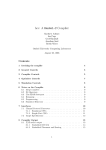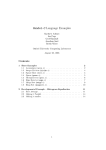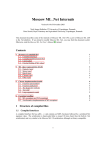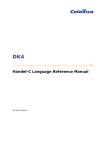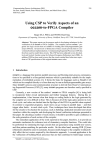Download Handel-C Language Reference Guide Contents
Transcript
Handel-C Language Reference
Guide
Matthew Aubury
Ian Page
Geo Randall
Jonathan Saul
Robin Watts
Oxford University Computing Laboratory
August 28, 1996
Contents
1 Structure of a Handel-C program
2 Declarations
2.1 Values : : : : : : : : : : : : : : :
2.1.1 Integer numbers : : : : : :
2.1.2 Booleans : : : : : : : : : :
2.2 Type expressions : : : : : : : : :
2.2.1 Integers : : : : : : : : : :
2.2.2 Expressions : : : : : : : :
2.3 External Declarations : : : : : : :
2.3.1 Constants : : : : : : : : :
2.3.2 Specications : : : : : : :
2.4 Target Declaration : : : : : : : :
2.5 Interface Declarations : : : : : : :
2.6 Internal Declarations : : : : : : :
2.6.1 Variables : : : : : : : : :
2.6.2 Channels : : : : : : : : : :
2.6.3 On-chip RAMs and ROMs
2.6.4 Expressions : : : : : : : :
2.6.5 Procedures : : : : : : : :
3 Statements
3.1
3.2
3.3
3.4
3.5
3.6
Parallel Composition : :
Assignment : : : : : : :
Channel Communication
Conditional : : : : : : :
While loops : : : : : : :
Do : : : While loops : : :
:
:
:
:
:
:
:
:
:
:
:
:
:
:
:
:
:
:
:
:
:
:
:
:
1
:
:
:
:
:
:
:
:
:
:
:
:
:
:
:
:
:
:
:
:
:
:
:
:
:
:
:
:
:
:
:
:
:
:
:
:
:
:
:
:
:
:
:
:
:
:
:
:
:
:
:
:
:
:
:
:
:
:
:
:
:
:
:
:
:
:
:
:
:
:
:
:
:
:
:
:
:
:
:
:
:
:
:
:
:
:
:
:
:
:
:
:
:
:
:
:
:
:
:
:
:
:
:
:
:
:
:
:
:
:
:
:
:
:
:
:
:
:
:
:
:
:
:
:
:
:
:
:
:
:
:
:
:
:
:
:
:
:
:
:
:
:
:
:
:
:
:
:
:
:
:
:
:
:
:
:
:
:
:
:
:
:
:
:
:
:
:
:
:
:
:
:
:
:
:
:
:
:
:
:
:
:
:
:
:
:
:
:
:
:
:
:
:
:
:
:
:
:
:
:
:
:
:
:
:
:
:
:
:
:
:
:
:
:
:
:
:
:
:
:
:
:
:
:
:
:
:
:
:
:
:
:
:
:
:
:
:
:
:
:
:
:
:
:
:
:
:
:
:
:
:
:
:
:
:
:
:
:
:
:
:
:
:
:
:
:
:
:
:
:
:
:
:
:
:
:
:
:
:
:
:
:
:
:
:
:
:
:
:
:
:
:
:
:
:
:
:
:
:
:
:
:
:
:
:
:
:
:
:
:
:
:
:
:
:
:
:
:
:
:
:
:
:
:
:
:
:
:
:
:
:
:
:
:
:
:
:
:
:
:
:
:
:
:
:
:
:
:
:
:
:
:
:
:
:
:
:
:
:
:
:
:
:
:
:
:
:
:
:
:
:
:
:
:
:
:
:
:
:
:
:
:
:
:
:
:
:
:
:
:
:
:
:
:
:
:
:
:
:
:
:
:
:
:
:
:
:
:
:
:
:
:
:
:
:
:
:
:
:
:
4
4
4
4
5
5
5
5
5
6
6
6
7
8
8
8
9
9
10
10
10
11
11
12
13
13
3.7
3.8
3.9
3.10
3.11
3.12
3.13
For loops : : : : : : : : :
Case : : : : : : : : : : :
Prioritised Alternations :
Stop : : : : : : : : : : :
Delay : : : : : : : : : :
Skip : : : : : : : : : : :
Procedure Calls : : : : :
4 Expressions
4.1
4.2
4.3
4.4
4.5
4.6
4.7
4.8
Values : : : : : : : : :
Arithmetic operators :
Relational operators : :
Logical Operators : : :
Bit Operators : : : : :
Conditional Operators
Operator Precedence :
Built-in Functions : : :
5 Language reference
5.1 Lexical Conventions : :
5.1.1 Blanks : : : : :
5.1.2 Comments : : :
5.1.3 Identiers : : :
5.1.4 Integer literals :
5.1.5 Keywords : : :
5.1.6 Ambiguities : :
6
Handel-C
:
:
:
:
:
:
:
:
:
:
:
:
:
:
:
:
:
:
:
:
:
:
:
:
:
:
:
:
:
:
:
:
:
:
:
:
:
:
:
:
:
:
:
:
:
:
:
:
:
:
:
:
:
:
:
:
:
:
:
:
:
:
:
:
:
:
:
:
:
:
:
:
:
:
:
:
:
:
:
:
:
:
:
:
:
:
:
:
:
:
:
:
:
:
:
:
:
:
:
:
:
:
:
:
:
:
:
:
:
:
:
:
:
:
:
:
:
:
:
:
:
:
:
:
:
:
:
:
:
:
:
:
:
:
:
:
:
:
:
:
:
:
:
:
:
:
:
:
:
:
:
:
:
:
:
:
:
:
:
:
:
:
:
:
:
:
:
:
:
:
:
:
:
:
:
:
:
:
:
:
:
:
:
:
:
:
:
:
:
:
:
:
:
:
:
:
:
:
:
:
:
:
:
:
:
:
:
:
:
:
:
:
:
:
:
:
:
:
:
:
:
:
:
:
:
:
:
:
:
:
:
:
:
:
:
:
:
:
:
:
:
:
:
:
:
:
:
:
:
:
:
:
:
:
:
:
:
:
:
:
:
:
:
:
:
:
:
:
:
:
:
:
:
:
:
:
:
:
:
:
:
:
:
:
:
:
:
:
:
:
:
:
:
:
:
:
:
:
:
:
:
:
:
:
:
:
:
:
:
:
:
:
:
:
:
:
:
:
:
:
:
:
:
:
:
:
:
:
:
:
:
:
:
:
:
:
:
:
:
:
:
:
:
:
:
:
:
:
:
:
:
:
:
:
:
:
:
:
:
:
:
:
:
:
:
:
:
:
:
:
:
:
:
:
:
:
:
:
:
:
:
:
:
:
:
:
:
:
:
:
:
:
:
:
:
:
:
:
:
:
:
:
:
:
:
:
:
:
:
:
:
:
:
:
:
:
:
:
:
:
:
:
:
:
:
:
:
:
:
:
:
:
:
:
:
:
:
:
:
:
:
:
:
:
:
:
:
:
:
:
:
:
:
:
:
:
:
:
:
:
:
:
:
:
:
:
:
:
:
:
:
:
:
:
:
:
:
:
:
:
:
:
:
:
:
:
:
:
:
:
:
:
:
:
:
:
:
:
:
:
:
:
:
:
:
:
:
:
:
:
:
:
:
:
:
:
:
:
:
:
:
Vs C
13
14
15
16
16
16
17
17
18
18
19
20
20
20
21
21
22
22
22
22
22
22
23
23
23
2
Foreword
Handel-C is a simple programming language designed to enable the compilation
of programs into synchronous, usually FPGA based, hardware implementations.
Handel is not a hardware description language though; rather it is a product of
a long term research programme at Oxford investigating `system codesign' { the
creation of systems comprised of both hardware and software components { from
a single program.
This research is underpinned by the belief that the engineering of any system
should be based on sound mathematical principles, and that this is especially
true of tomorrow's large-scale and highly parallel systems. So while the syntax of Handel-C reminiscent of that of Kernigan and Ritchie's C programming
language, Handel is founded on the semantics of Hoare's CSP algebra.
It should be emphasised that Handel-C and the associated software are
very much part of developing research projects, and are subject to considerable
changes.
This document describes the fundamentals of the Handel-C language. It does
not concern the hcc compiler or the Harp recongurable computing platforms
which are often used with it. These are covered in [8] and [5, 6, 7] respectively.
Some examples of Handel-C programs are contained in [9].
Acknowledgements
We would like to acknowledge the work of everyone in the Oxford Hardware
Compilation Group, and all those involved in the development of Standard ML
of New Jersey, Caml light and MOSML.
3
1 Structure of a Handel-C program
A Handel-C program is structured as follows:
external declarations
void main(target
f
g
declaration, interface declarations)
internal declarations
statements
The section external declarations (see Section 2.3) deals with setting up global
constants (such as the widths of data buses) and of dening specication elds
to describe external interfaces.
The section target declaration (see Section 2.4) is optional and allows the user
to dene the target technology for the circuit.
The section interface declarations (see Section 2.5 declares the communication
channels between the Handel-C program and the outside world.
Inside the body of the program, there are a set of internal declarations (which
can include constants, variables, arrays, channels, on-chip RAMs and ROMs,
subexpressions and procedures), followed by a sequence of statements (see Section 3). This is much like conventional C, except for the way procedures are
declared within the body of main. Further declarations can be made inside procedure declarations or blocks of code denoted by { and }.
2 Declarations
This section details the types of declarations that can be made, as described in
the previous section. It is important to understand how the type system diers
from that of conventional C, and therefore this is dealt with rst.
2.1 Values
This section describes the kinds of values that are manipulated by
programs.
Handel-C
2.1.1 Integer numbers
Integer constants in Handel-C may range over any values. Note that constants
may be formed directly by using large denotations, or they can also be formed
by the bitwise concatenation of two or more such constants together (see section
4.5).
4
2.1.2 Booleans
For convenience, the synonym bool is provided for single bit integers. The compiler treats objects of these types identically, so they may be used interchangably.
Additionally the keywords false and true are synonyms for the constants 0 and
1, both of bit width 1.
2.2 Type expressions
As the compiler target is custom hardware, the conventional notion of types is
extended slightly in Handel-C. Where in conventional programming languages we
would have a single type, Handel-C provides a class of types each distinguished
by the number of bits used to represent values. This allows the programmer to
control the amount of hardware used to represent data.
2.2.1 Integers
Rather than just dening values to be of type int, Handel-C encourages programmers to dene values which have an explicit bit-width as well. For example:
int x, y :
int z;
16;
denes x and y to be integer variables, each 16 bits wide. Integer variables can
still be dened unwidthed (as in the case of z above), but the widths of such
variables will be inferred from the context of the rest of the program at compile
time. If the compiler fails to infer the width of any such construct, an error is
reported.
2.2.2 Expressions
An expression may also be given an explicit width in order to help the width
inference engine to correctly assign a width to every expression in the program.
The width cast binds tightly so that brackets are usually necessary, as in the
following example which says that the result of the expression should be exactly
16 bits:
(a+b-c) :
16
Note that this width cast does not allow an expression of a particular width
to be treated as if it were another width. That job is done by the bit operations
(see section 4.5). In fact, the example above has the eect of giving the width 16
to each one of the variables a, b and c (since they must all be equal in width)
and hence the declarations of these variables need not contain this information.
2.3 External Declarations
Only constants and specication elds may be given outside main.
5
2.3.1 Constants
Constant integers or booleans may be declared with or without a width, as
follows:
const x = 1, y = 2, z = 3;
const a = 64 : 8;
Giving widths to constants is useful in padding out integers and xing problems with uninferrable widths. For example an expression like x @ 0 < y @ 0
is uninferrable because no information about the width of the constants can be
deduced. The x is to replace at least one of the zeroes with a constant 0 whose
width is specied.
2.3.2 Specications
Specications are free-form constants used to describe interfaces and the target
architecture. The format is as follows:
f
const spec name =
name =
name, name ...
name =
,
name = name
f
fg
name
g,
g
An example is the declaration of the \high" static RAM bank on the HARP
board, which is written as follows:
const spec harp1hram =
f
g;
addr =
f
data =
f
ce
wb
en
=
=
=
"P6", "P3", "P8", "P4", "P10", "P9", "P12", "P11",
"P14", "P13", "P21", "P15", "P18", "P17", "P23" ,
"P31", "P27", "P30", "P24", "P25", "P26", "P29", "P28",
"P38", "P39", "P37", "P32", "P33", "P34", "P36", "P35" ,
"P22",
"P5", "P7" ,
"P7", "P16"
f
f
g
g
g
g
2.4 Target Declaration
The target declaration is placed in the argument to main(...). It allows the
specication of technology specic information. Target declarations follow the
form:
target =
6
spec
where the spec eld is either a a braced specication or a const spec declared
externally.
This is an example of such a data structure for the Harp1 card.
f
const spec harp =
fpga type
fpga chip
clock pad
not error pad
finish pad
clock divider
carry weight
critical weight
;
g
=
=
=
=
=
=
=
=
"Xilinx3000",
"3195PQ160-3",
"P160",
"P55",
"P44",
"1",
"50",
"100"
void main(target=harp)
g
f
...
2.5 Interface Declarations
Interface declarations are placed in the argument to main(...). Allowable declarations are channels, ports and external RAMs. Channel declarations are written as chan(in) name : width and chan(out) name : width for transputer
communications to and from the FPGA respectively. External RAM declarations
follow the convention:
eram name[number
of elements]
=
spec
:
width
Once declared, an external RAM has an address width of dlog2 ne, where n
is the number of elements declared. The spec eld may be either the name of a
const spec declared externally, or may be a full spec eld, enclosed in braces.
An example is as follows:
/* Include definition of harp1l memory bank */
#include "harp.h"
const dw = 8;
void main (chan (out) stdout : dw,
chan (in) stdin : dw,
eram image[16384] = harp1l :
f
...
g
body ...
7
dw)
2.6 Internal Declarations
Internal declarations can be made immediately within the main block or within
any braced block within the body of main (including procedures). Normal scoping rules are used. Objects that may be declared within blocks are constants,
variables, channels, on-chip RAMs and ROMs, expressions and procedures. Constants are declared as before (in external declarations), and the remainder are
declared as follows.
2.6.1 Variables
Ordinary variables are declared exactly as in conventional C, except for the
optional width constraint. The following are all acceptable declarations:
int x, y;
int a, b :
int p, q :
bool p;
8;
dw;
The rst two declarations declare two integers, whose width must be inferred
from other statements in the program in order to avoid an error. The constant
dw must have already been declared for the third declaration to be valid. Initial
values may be attatched to registers, as in conventional C:
int x = 9, y = 6 :
dw;
This will cause the compiler to insert initialisation statements in the relevant
place (and thus will cause the block to take an extra cycle to execute). The
exception to this rule is at the beginning of main:
f
void main()
int x = 0 :
:::
8;
The initialisation to zero will not generate an extra statement since all registers are reset to zero at the entry point by a global reset.
2.6.2 Channels
Channels are declared similarly to those in the interface declarations. The following are all valid channel declarations:
chan
chan
chan
chan
x, y;
p, q : 8;
int z : dw;
bool a, b;
8
Unlike external channel declarations, internal channel declarations do not
have directions attached, since both output and input statements must be within
the scope of the declaration. Note that there may be multiple output and multiple
input statements for any one channel. The compiler warns if any single process
uses the same channel for both input and output, or if more than one parallel
process uses the same channel for either input or output. In typical usage,
exactly one parallel process will use an internal channel for output, and exactly
one process will use the same channel for input.
2.6.3 On-chip RAMs and ROMs
On-chip RAMs and ROMs are declared as follows:
ram
ram
ram
rom
rom
x[n] : dw;
int z[4] : 16;
bool q[20];
a =
3, 4, 5, 6
: 8;
bool b =
0, 1, 1, 0 ;
f
f
g
g
Rom declarations contain the information to be held within the ROM as a
comma separated list: the size of the address bus of the rom will be dlog2 ne,
where n is the number of elements declared as being in the ROM. If a larger
value is required the ROM must be padded with null elements (e.g. zero).
The cost of implementation of RAMs and ROMs is highly dependent on
the target architecture: the Xilinx 3000 series requires latches to implement
memories, whereas the Xilinx 4000 has dedicated on-chip RAMs available. The
most important aspect of ROMs and RAMs is that only one element may be
accessed in any clock cycle.
2.6.4 Expressions
Expression declarations allow the construction of explicit subexpressions. Since
hardware is generated for every expression, if an expression (or any subexpression) is to be used more than once it is advisable to declare it separately in order
to save hardware. The optimiser does a certain amount of common subexpression
elimination, but this may not always be eective.
The following are valid subexpression declarations:
int p() = q + r : 8;
int bob() = ((x <- 3) + (y >> 1)) @ multiplier;
In an expression declaration every term must already have been declared.
The name given to the expression can be used in any further expression declaration or expression in the body of the program, and will have the value of the
expression declared on the right hand side. Widths may be given to expression
declarations as shown in the rst example. Parameters may not be passed to
expressions, but the syntax (the brackets are not optional) leaves room for this
feature to be added to the language in future.
9
2.6.5 Procedures
Procedures are quite unlike those in conventional C, but in many circumstances
they may be used in a similar fashion. At present, procedures are parameterless,
and have no return value, so values may only be communicated by use of global
variables or channels. Only one invocation of a particular procedure can be in
execution at any one time, thus prohibiting recursion, mutual recursion, and
multiple calls from parts of the program operating in parallel. They are declared
within the body of main (indeed, they may even be declared within procedures
themselves), as follows:
name() f
...body of the procedure...
void
g
Neither the void nor the brackets are optional. Procedures are called with
a statements like foo();, as in conventional C, but, since procedures return no
values, they can not be used in expressions.
3 Statements
As Handel-C is targetted onto custom hardware, the programmer will be highly
aware of both the time and space requirements of the program. Consequently, it
makes sense to discuss the timings of statements in the language. Each statement
takes a number of clock cycles to execute. Exactly how many clock cycles each
instruction requires to execute can depend on the values of variables, or, in
the case of channel communication, on when another process is prepared to
cooperate.
In addition, it is extremely important to make as much use as possible of
parallelism, since it is essentially free in hardware. There are two statement
constructors available to this end: parallel assignment and parallel composition.
Parallel assignment allows values to be assigned to a number of variables in one
clock cycle. Parallel composition allows statements in a block to be executed
in parallel. The semicolon, sometimes regarded as a sequential composition
operator, instead has the meaning of statement terminator in Handel-C.
3.1 Parallel Composition
The par statement composes a series of statments in parallel. All the statements will commence execution at the same instant, and the par statement will
terminate execution when all branches have terminated. The format is as follows:
par
f
statement;
.
.
.
g
statement;
10
To understand exactly what gets done in parallel, an example is helpful:
int x, y;
par
g
f
x = 1;
y = 1; x = x + 1;
f
g
In this program, on the rst cycle the statments x = 1; and y = 1; will be
executed in parallel. The rst branch will then terminate. On the second cycle,
the statement x = x + 1; will be executed, and this branch will then terminate,
and as a result the par will terminate. On the next cycle, any statements following
the par will then be executed.
This program will generate a warning, since the variable x is used in both
branches. However, its usage is safe since it is never assigned to by both branches
simulatanously.
Timings A par statement takes exactly as many cycles to execute as its longest
branch. There is no overhead in its execution.
3.2 Assignment
Assignments in Handel-C take the form:
variable f, variableg
=
expr f, exprg
When this statement is executed, all the expressions on the right hand side
are evaluated, and then all the assignments are performed. Thus the nal value
of x in the following code fragment is 4, not 5.
y = 2;
y, x = y + 1, y + 2;
Assigments involving the same variable more than once on the left hand side are
in error, as are assignments from/to objects of diering widths.
Timings Every assignment statement takes one clock cycle to execute.
3.3 Channel Communication
Channel communication is identical for internal channels and communication
across the FPGA interface. Reading from a channel is as follows:
channel
?
11
variable
Where the variable may also be an array element or memory element. Writing
is as follows:
channel
!
expression
where there are no restrictions on the expression. In both cases the width of the
channel must be the same as the width of the variable or expression.
No two statements may simultaneously write to a channel. Simultaneous
reads may be possible but are not supported; they should only be used where
the timing of the communication is precisely known so that both readers can
use exactly the same clock cycle to do their simultaneous read, otherwise it is
possible that two reads may be scheduled when only one was intended.
There are variants of the input and output commands with which the programmer can specify that a partner to a communication denitely will be ready
to communicate whenever the command is scheduled. The compiler can use
this guarantee to save some synchronisation hardware. This may be useful when
communicating with external channels where the environment is always receptive.
Examples might be reading or writing an external device register, or sampling a
data line. The single-tick input and output commands are:
channel
?'
variable channel
!'
expression
Timings Both reads and writes enter a waiting state until the converse opera-
tion is performed elsewhere on the channel. This will continue for as many cycles
as necessary. If both reader and writer are ready, the communication occurs in
precisely one cycle (the time taken to update the variable).
3.4 Conditional
Handel-C
low:
provides the standard C conditional execution constructor, if, as beif (bool)
statement
else
statement
As usual in C the else clause can be omitted if not required. For example:
f
if (x == 1)
x = x + 1;
x = x * 2;
g
Timings The if statement takes as long to execute as whichever of its component statements does (i.e. there is no overhead for the if itself).
12
3.5 While loops
While loops are provided exactly as in C.
while (expr)
statement
The contents of a while loop may be executed zero or more times.
Timings A while takes no time over and above the time taken to execute the
loop body as many times as required.
3.6 Do
:::
While loops
Do : : : While loops are provided exactly as in C.
do
statement
while (expr);
Unlike while and for loops, the bodies of
executed at least once.
Timings
do
do
: : : while loops are always
: : : while loops incur no overhead, and so the execution time is a
product of the time taken to execute the statement and the number of interations
(which is a minimum of 1).
3.7 For loops
The for statement is supplied similar to conventional C.
for (initialisation ;
loop body
test
;
iteration)
where initialisation is a simultaneous assignment or other statement which sets
up the variables before the rst execution of the loop, test is a boolean expression
which must evaluate to true for execution of the loop to continue, and iteration
is a simultaneous assignment or other statement which adjusts these variables
for the next iteration of the loop. The only dierence to conventional C is that
multiple comma separated statements are not allowed in the initialisation and
iteration positions and the test can only be a boolean expression.
A typical code fragment might look like this:
for (x = 0 ; x < y ; x = x + 1)
out ! x;
in ? z;
g
13
f
A for loop may be executed zero or more times according to the results of
the test. Each of the initialisation, test and iteration statements are optional,
and can be omitted if not required. There is a direct correspondence between
for and while loops.
for (init;
body;
test; inc)
is equivalent to:
f
init;
while (test)
body;
g
g
f
inc;
Timings The exact number of cycles a for command executes in is determined
by the behaviour of its component statements. Initialisation takes as long as the
statement itself does, and there is no overhead in clock cycles for the test. The
body of the loop takes as many clock cycles as the statements in the body plus
the increment statement.
Thus, a for statement with initialisation, iteration, and increment statements
all taking constant time, will take i + n (m + c) cycles to complete, where i is
the number of cycles required for initialisation, n is the number of times the loop
body is executed, m is the number of cycles to execute the loop body, and c is
the number of cycles needed to perform the increment. Any omitted statements
default to skip, and hence take zero cycles to execute.
3.8 Case
The case constructor can be used as in C to choose actions according to the value
of a variable. The syntax, however, diers signicantly from that of conventional
C.
case (expr)
f
int f, int ...g:
statement;
int f, int ...g:
statement;
:::
default:
g
statement;
14
The case expression is evaluated and checked against each of the integer
constants used to label the guarded statements. The integer constants should
be non-overlapping. The statement guarded by a matching constant is selected
for execution. If no matches are found, the default statement is executed. If no
default option is provided, stop is assumed.
Timings A switch takes no clock cycles to determine which branch to choose,
and thus terminates in as many clock cycles as the statement in the selected
branch takes to terminate.
3.9 Prioritised Alternations
A prioritised alternation, is a program construct that allows the direction of
control ow to be chosen between a set of alternatives, based upon a combination
of boolean guards, and input statements.
prialt
f
expr
$
channel input
statement
expr
:
:
statement
channel input :
statement
g
:::
When executed, each branch of the prialt is examined in turn. The rst
branch that has both a true boolean guard, and a channel input that can complete
immediately (i.e. another process is already trying to output down the channel),
will be executed. Only one branch of the prialt will be executed each time the
prialt is run. If no branch has both a true boolean guard and a channel input
request which can be immediately satised, then the prialt statement will wait
until one does.
Either the boolean guard or the channel input (but not both) may be omitted.
In the case of an omitted boolean guard, true is assumed, and in the case of an
omitted channel input, no synchronisation with a parallel process is performed.
For example:
15
prialt
g
f
reading $ read ? x :
write ! x;
stalled :
write ! 0;
read ? x :
stop;
true :
delay;
Here, whenever data is being oered on the channel read, and reading evaluates to true, the input will take place, the rst branch will be executed and
the prialt will terminate. Otherwise, the construct continues to consider later
branches.
Timings A prialt command takes just as long as the branch it executes to
complete plus the number of clock cycles initially taken for that branch to become
ready for execution.
3.10 Stop
The program statement stop in Handel-C terminates execution of the process
immediately. Any process running in parallel with stop will continue to run.
Timings A stop statement takes innite time to execute.
3.11 Delay
The program statement delay in Handel-C corresponds to a statement to do
nothing, but to take exactly one cycle to do it. This is useful to avoid resource
conicts (for instance, when using RAMs and ROMs), amongst other things. The
statement delay n is also supported where n is an non-negative integer constant
and the corresponding delay is n clock cycles.
Timings A delay statement takes 1 clock cycle.
3.12 Skip
The program statement skip in Handel-C corresponds to a statement to do
nothing, and to take no time doing it. It may be useful for statements such as
prialts, to denote an empty input guard.
Timings A skip statement does nothing and takes no time to execute.
However there are a (very) few places in the language where a statement must
take at least one clock cycle to execute, such as the body of a loop. This is a
consequence of the design decision that the while loop should execute in exactly
16
the time taken by the sum of the actual execution times of the loop body (even
if there are zero of them).
If it were permitted for the body of the loop also to execute in zero cycles,
that would imply that the timing semantics of Handel-C were unimplementable
(and the compiler would end up producing a combinational loop in the control
logic). Hence such programs as
while (1)
if (e) skip; else a=b;
are syntactically banned in Handel-C because there is the potential for the loop
body to execute in zero cycles.
However, the compiler will, by default, automatically convert such skip statements to delay statements in order that the program can be compiled. The user
is always warned of these conversions, since it may, in a few cases, be better to
convert them by hand rather than to allow the compiler to judge which particular
conversions to make.
3.13 Procedure Calls
Procedure calls are made in the following way:
name();
No parameters may be passed, and no return value is given. Procedure
calls are statements and therefore may not appear in expressions. Recursive and
mutually recursive procedures are not allowed. The states of any local variables
in a procedure are maintained between calls. It is important to avoid overlapping
calls when calling the same procedure twice in parallel, since unusual results can
arise (a warning will be generated by the compiler).
Timings The time taken for a procedure call to execute is exactly as long as
for the body of the procedure itself to execute, i.e there is no overhead in the call
mechanism.
4 Expressions
Expressions in Handel-C take no time to be evaluated, and so have no bearing on
the number of clock cycles a given program takes to execute. They do however
aect the maximum possible clock-speed for a program. The more complex an
expression, the more hardware will be involved in its evaluation and the longer
it is likely to take. The clock cycle time for the entire hardware program will
be set by the longest such evaluation in the whole program. Procedure calls
and assignments are prohibited within expressions. Consequently the familiar C
constructs of ++ and -- are not supported by Handel-C.
17
4.1 Values
There are several types of value that can be used in an expression, and constants
and variables may be used without restriction.
However, there are some unusual restrictions on the use of RAMs and ROMs.
Because of their architecture, RAMs and ROMs are restricted to performing
operations sequentially; this doesn't t well with the highly parallel nature of
most hardware. Only one element of an on-chip RAM or ROM may be addressed
in any given clock cycle, and, as a result, familiar looking statements are often
disallowed, for example:
ram x[4];
x[1] = x[3] + 1; /* This is illegal */
The following statement is also disallowed:
ram x[4];
if (x[0] == 0) x[1] = 1; /* This is illegal */
This is because the expression evaluation and the assignment take place in the
same clock period. This problem can be avoided by placing a delay statement
before the assignment (and in some cases, putting a delay in the else part). This
problem will also crop up with other constructs such as while.
The same problems occurs when using external RAMs. Clearly only one
external RAM access may be made per cycle (per external RAM), and these
may take place on either the left or right hand side of an assignment, in channel
communications, in switch statements and in if statements. They may not
occur in loop controlling conditions, or in prialts.
The nal type of value is any. This can be used in channel communications to
indicate that a channel read should occur but that the value should be discarded,
or that a channel write should occur but its value will be undened. Its value in
expressions is also undened.
4.2 Arithmetic operators
The following arithmetic operators are dened in Handel-C:
+ - * .*.
The rst three have the usual meanings of addition, subtraction and multiplication. The .*. operator designates unsigned multiplication. + and - require
both operand expressions to deliver results of the same width. Any attempt to
add two expressions with diering widths will cause a compilation error. The
expression returned has the same number of bits as the original two expressions.
Any bits that overow during the calculation are lost.
For instance:
18
const x = 10 : 4;
const y = 8 : 4;
z = x + y;
will put 2 into z because of overow of the 4-bit result.
Both * and .*. will accept expressions of diering widths, say m and n
bits respectively, and return an expression n + m bits wide. For instance, in the
following code fragment, z must be 7 bits wide.
const x = 8 :
const y = 5 :
z = x .*.
4;
3;
y;
There is no runtime division operator provided by Handel-C, but div and
several other operators are provided for use only when describing constants.
a mod b
a modulo b
a div b
t(a=b)
log2 (a) t(log2 a)
These operators will raise an error if used in non-constant expressions. Some
examples of use are:
const
const
const
const
x
y
z
w
=
=
=
=
10 : 4;
7 : 3;
x div y;
10 mod 7 :
log2(z);
4.3 Relational operators
The following relational operators are dened in
signed numbers:
Handel-C
for signed and un-
Operator
Signed Unsigned
Equal
==
==
Not Equal
!=
!=
Less Than
<
.<.
Greater Than
>
.>.
Less Than or Equal
<=
.<=.
Greater Than or Equal >=
.>=.
In all cases, both sides must have the same bit width. The result of any of
these comparisons is a single bit with 0 representing false, and 1 representing
true, as usual.
19
4.4 Logical Operators
The following logical operators are dened in Handel-C:
& | ^ ~
These have the meanings of AND, OR, exclusive-OR and NOT respectively.
Note that NOT is written with ~ rather than ! to dierentiate it from channel
communication.
4.5 Bit Operators
The following bit operators are dened in Handel-C:
<< >> <-
nn
@ .
Left and right logical shifts are implemented in Handel-C using << and >>
respectively. The bit width of the result is the same as the width of the number
being shifted, the additional spaces being padded with zeroes.
The amount that a value is shifted by must be a constant, since shifts by
variable amounts are not implemented (constant shifts require no hardware, but
variable shifts would require a great deal). Handel-C contains special constructors for taking or dropping numbers of bits from an expression. For an n bit
expression e, (e <- m) will return an expression formed from the least signicant m bits of e. Similarly, (e nnm) will return an n ; m bit expression formed
from all but the m least signicant bits of e. m must be a constant expression.
Two expressions can be bitwise concatenated to form a wider expression.
For an m bit expression e and an n bit expression f, (e @ f) will return an
m + n bit expression which has e as the most signicant bits, and f as the least
signicant bits1 .
An expression can be subscripted by constants to extract one or more bits
from its representation:
e.5
e.(5..7)
In the rst example, the value denoted is that of bit 5 in the representation
of the value of e (bit 0 being the least signicant). In the second example, it is
the 3-bit eld consisting of bits 5 through 7 of e.
4.6 Conditional Operators
Two conditional operators exist in Handel-C. One is very similar to the C conditional except that all its elements must be expressions:
max = (a > b ?
1
a :
b);
Note that this is the opposite sense from Handel-AS and from earlier versions of Handel-C
20
The rst expression must always be a boolean. In this example, the boolean
expression (a > b) is evaluated and the value of the whole conditional is the
value of the second expression (here a) if the boolean evaluates true, otherwise it
is the value of the third expression (here b). As with all expressions in Handel-C,
the whole conditional expression evaluates within one clock cycle. Both of the
selectable expressions must have the same width.
The second form of conditional expression is a generalisation of the rst and
can have as many alternative as needed. It necessarily has a dierent syntax
from the rst form in order to remove parsing ambiguities:
cond (e, c1->e1, c2->e2, c3->e3, ..., default->d);
In this form, each of the ci are constant expressions which must each be
distinct, and the expressions ei are width compatible expressions. The expression e is evaluated and if its value matches any one of the ci, then the value of
the whole conditional is the value of the corresponding ei. If no value matches,
then the value of the conditional is given by the default expression d. If the ci
exhaustively cover all of the possible values of e then the default clause must be
omitted, otherwise it is mandatory.
4.7 Operator Precedence
The precedence and associativity of operators in Handel-C is shown in the following list. Operators higher in the list are given higher precedence than operators
lower in the list. Operators on the same line have the same precedence.
right
right
left
left
left
left
left
left
left
left
left
left
right
left
=
:
|
&
^
== !=
< > <= >= .<. .>.
@
<<< >>
+ * .*.
mod div
~
. ..
.<=.
.>=.
nn
4.8 Built-in Functions
There are a number of built-in functions in Handel-C. In common with all
functions they actually designate expressions, so that they all evaluate
within one clock cycle. In the following, #e designates the width of expression
e.
Handel-C
21
Function
abs (e)
rxrdy(c)
txrdy(c)
exp2 (e)
Returns
Width
absolute value of expression e
#e
true if channel c is ready to receive
1
true if channel c is ready to transmit
1
e
#
2
2 e
5 Language reference
The syntax of the language is given in BNF-like notation. Terminal symbols
are set in typewriter font (like this). Non-terminal symbols are set in italic
font (like that). Square brackets [: : : ] denote optional components. Braces f: : : g
denotes zero, one or several repetitions of the enclosed components. Braces
with a trailing plus sign f: : : g+ denote one or several repetitions of the enclosed
components. Parentheses (: : : ) denote grouping.
5.1 Lexical Conventions
5.1.1 Blanks
The following characters are considered as blanks: space, newline, horizontal
tabulation, carriage returns, line feed and form feed. Blanks are ignored, but
they separate adjacent identiers, literals and keywords that would otherwise be
confused as one single identier, literal or keyword.
5.1.2 Comments
Comments are introduced by the two characters /*, with no intervening blanks,
and terminated by the characters */, with no intervening blanks. Comments are
treated as blank characters. Nested comments are not handled; a lexer error will
be raised if any are encountered during parsing.
/* This is a legal comment. */
/* This is /* NOT */ a legal comment */
5.1.3 Identiers
ident ::= letter fletter j 0 : : : 9 j g
letter ::= A : : : Z j a : : : z
Identiers are sequences of letter, digits, and (the underscore character),
starting with a letter. All characters in an identier are meaningful and all
identiers are case-sensitive.
5.1.4 Integer literals
integer ; literal ::= [;]f0 : : : 9g+
j [;](0x j 0X)f0 : : : 9 j A : : : F j a : : : fg+
22
j [;](0o j 0O)f0 : : : 7g+
j [;](0b j 0B)f0 : : : 1g+
An integer literal is a sequence of one or more digits, optionally preceded by
a minus sign. By default, integer literals are in decimal (radix 10). The following
prexes select a dierent radix:
0x, 0X
0o, 0O
0b, 0B
hexadecimal (radix 16)
octal (radix 8)
binary (radix 2).
(The initial 0 is the digit zero; the O for octal is the letter O.)
5.1.5 Keywords
The identiers below are reserved as keywords, and cannot be employed otherwise:
any
const
eram
int
port
spec
while
bool
default
false
led
prialt
stop
bus
delay
for
main
ram
target
case
div
if
mod
rom
true
chan
do
in
out
seq
tsport
cond
else
inout
par
skip
void
The following character sequences are also keywords:
{
<
.<.
#
+
^
<-
}
>
.>.
;
~
->
(
<=
.<=.
,
*
?
@
)
>=
.>=.
:
.*.
!
\\
[
==
<<
$
&
?'
.
]
!=
>>
=
|
!'
..
5.1.6 Ambiguities
Lexical ambiguities are resolved according to the \longest match" rule: when a
character sequence can be decomposed into two tokens in several dierent ways,
the decomposition retained is the one with the longest rst token.
6
Handel-C
Vs C
While Handel-C was designed to look and feel as much as possible like a variant
of C, the nature of the target architecture is such that certain C language features
are inappropriate. These have therefore been removed in Handel-C.
23
Similarly, C was found not to contain some constructors vital to the expressiblilty of concepts like parallelism. Accordingly several new operators have been
added. The tables below summarise these operators available.
It is worth noting that assignment is not part of the of the expression language
in Handel-C, so the following code, which is perfectly legal (though arguably bad
style) in C is not permitted.
void main(void)
f
g
int a, b;
if (a = 1) b = 2
As a side eect of this the commonly used
available.
24
++
and
--
operators are not
+
*
<<
>>
<
>
<=
>=
==
!=
&
^
|
? :
[]
f;g
In Both
(negation)
(multiply)
(boolean and)
(boolean exor)
(boolean or)
(conditional)
(arrays)
In Both
case/switch
do while
while
if else
for (;;)
int
const
void
In Both
->
.
!
++
-*
&
sizeof
/
%
&&
||
Expressions
In C Only
(no structs)
(logical negation)
(indirect)
(divide)
(modulo)
(logical and)
(logical or)
Statements
In C Only
break
continue
return
goto
typedef
Types and type operators
In C Only
char
double
enum
float
long
short
register
static
extern
struct
volatile
unsigned
25
?
!
<-
nn
.<.
.>.
.<=.
.>=.
@
In Handel-C only
(Channel input)
(Channel output)
(take)
(drop)
(unsigned ops)
(concat)
In Handel-C only
fg
par
prialt
stop
skip
chan
bool
spec
eram
ram
rom
fg
In Handel-C only
References
References
[1] Michael Spivey and Ian Page. \How to design hardware with Handel", Technical Report, Oxford University Computing Lab, 1993.
[2] Ian Page and Wayne Luk, \Compiling OCCAM into FPGAs" in FPGAs,
Eds Will Moore and Wayne Luk, 271-283, Abingdon EE & CS books, 1991.
[3] Geraint Jones, \Programming in OCCAM", Prentice-Hall International,
1987.
[4] INMOS Ltd, \The OCCAM2 Programming Manual", Prentice-Hall International, 1988.
[5] A E Lawrence, \HARP (TRAMple) Manual, Volume 1, User Manual for
HARP 1 and HARP 2", 1995.
[6] A E Lawrence, \Macro support for the Xilinx Architecture", 1996.
[7] A E Lawrence, \The HARP software library and utility package", 1996.
[8] M Aubury, I Page, G Randall, J Saul, R Watts, \hcc: A Handel-C Compiler", 1996.
[9] M Aubury, I Page, G Randall, J Saul, R Watts, \Handel-C Program Examples", 1996.
26


























